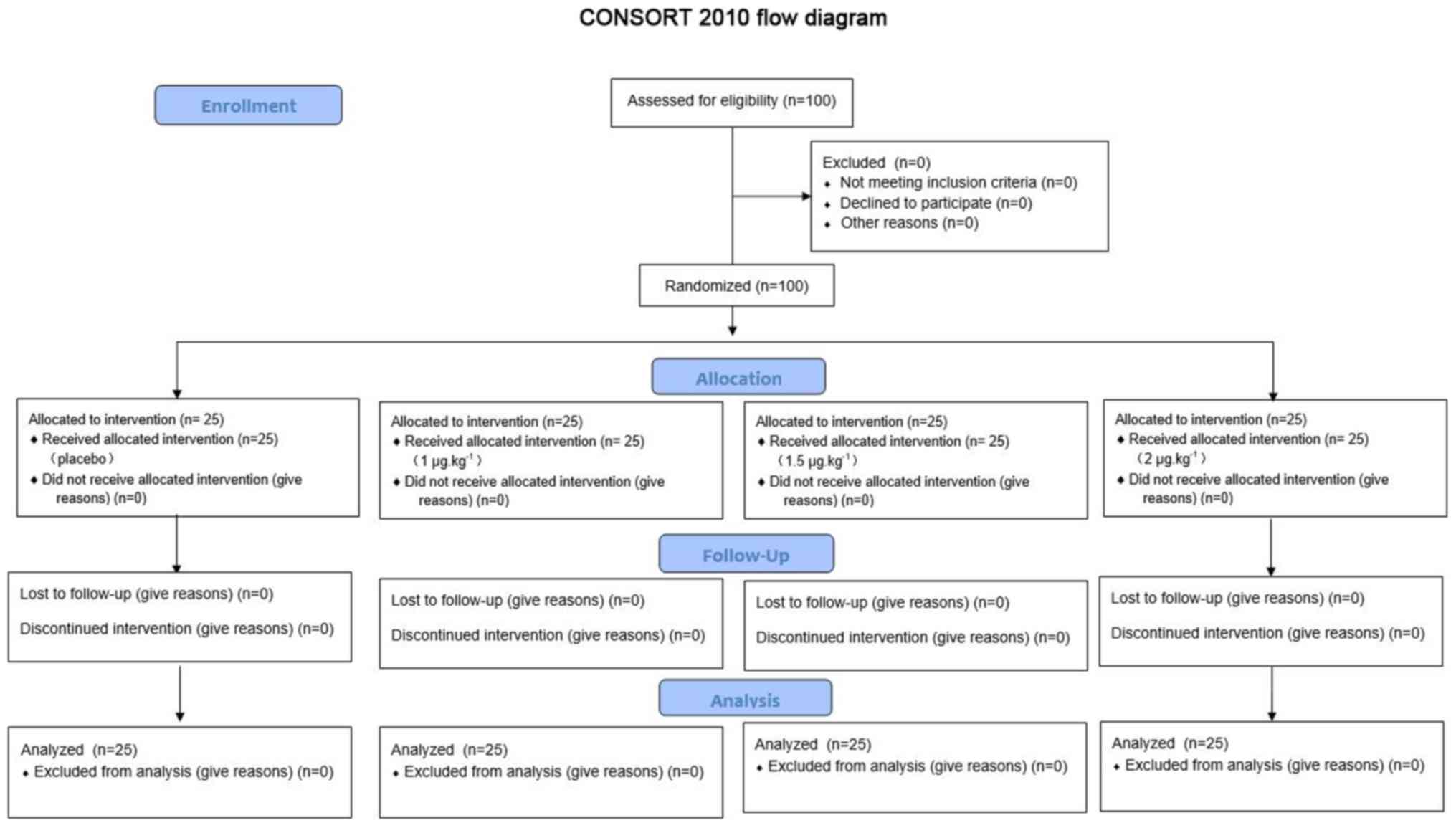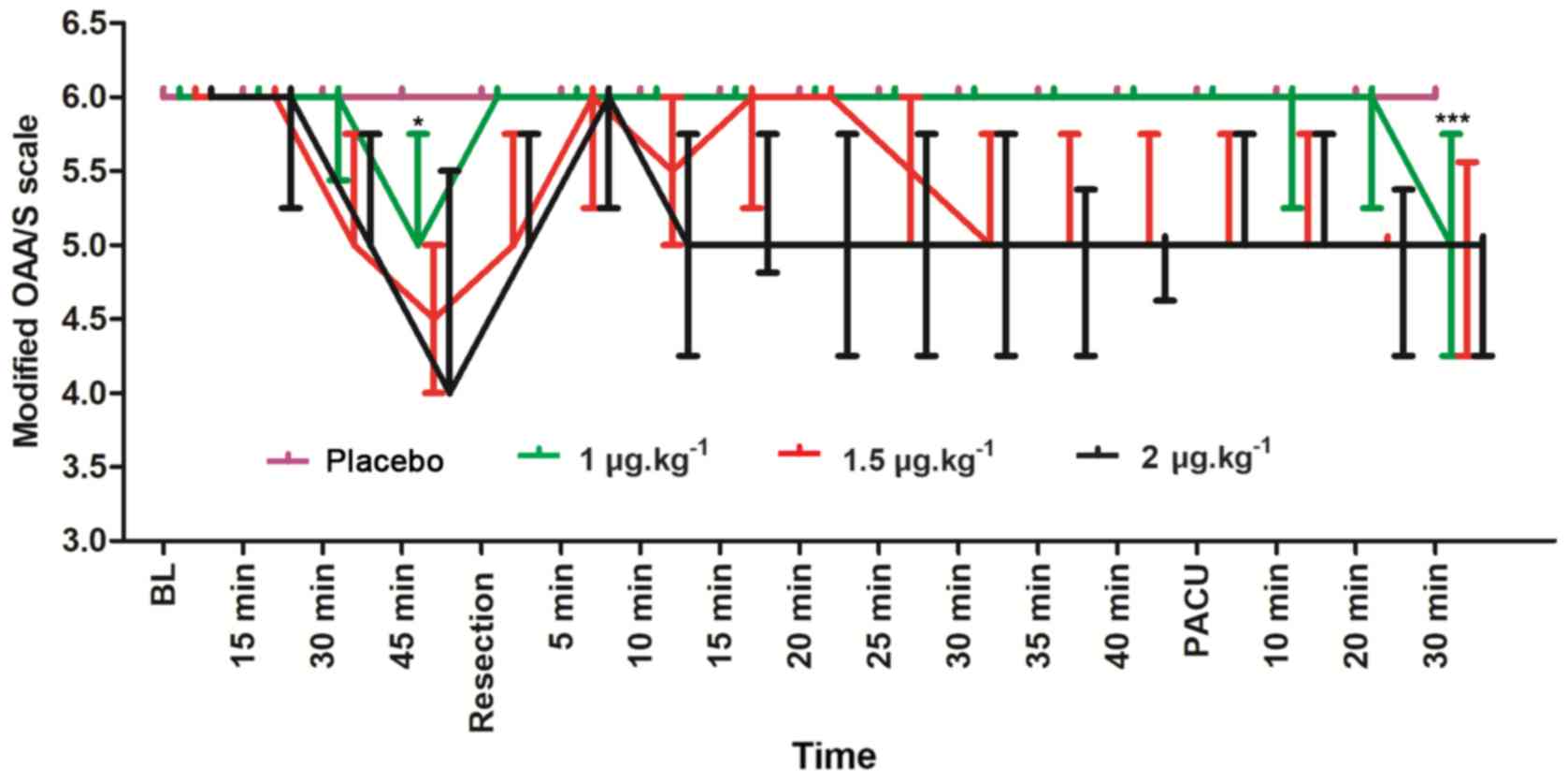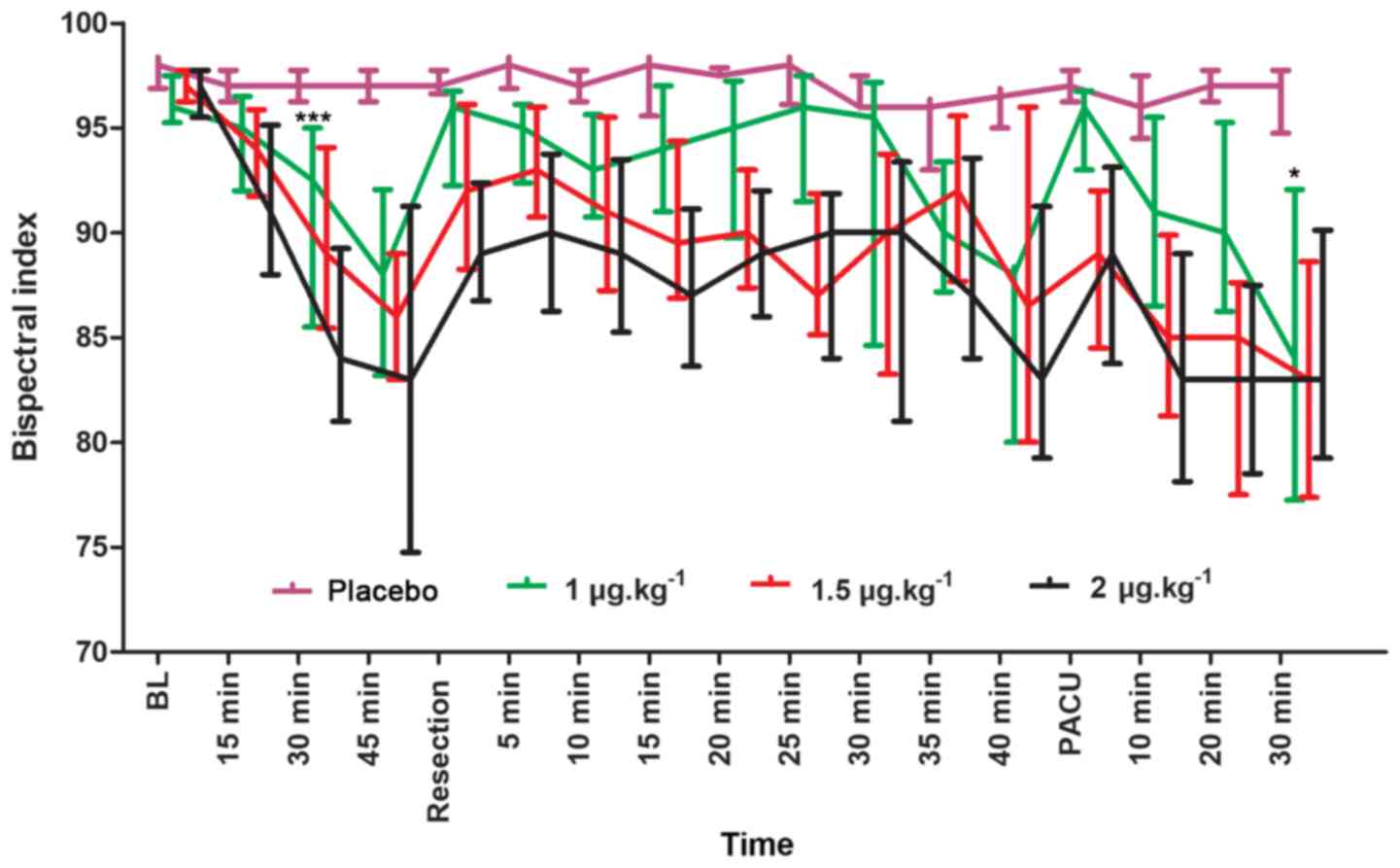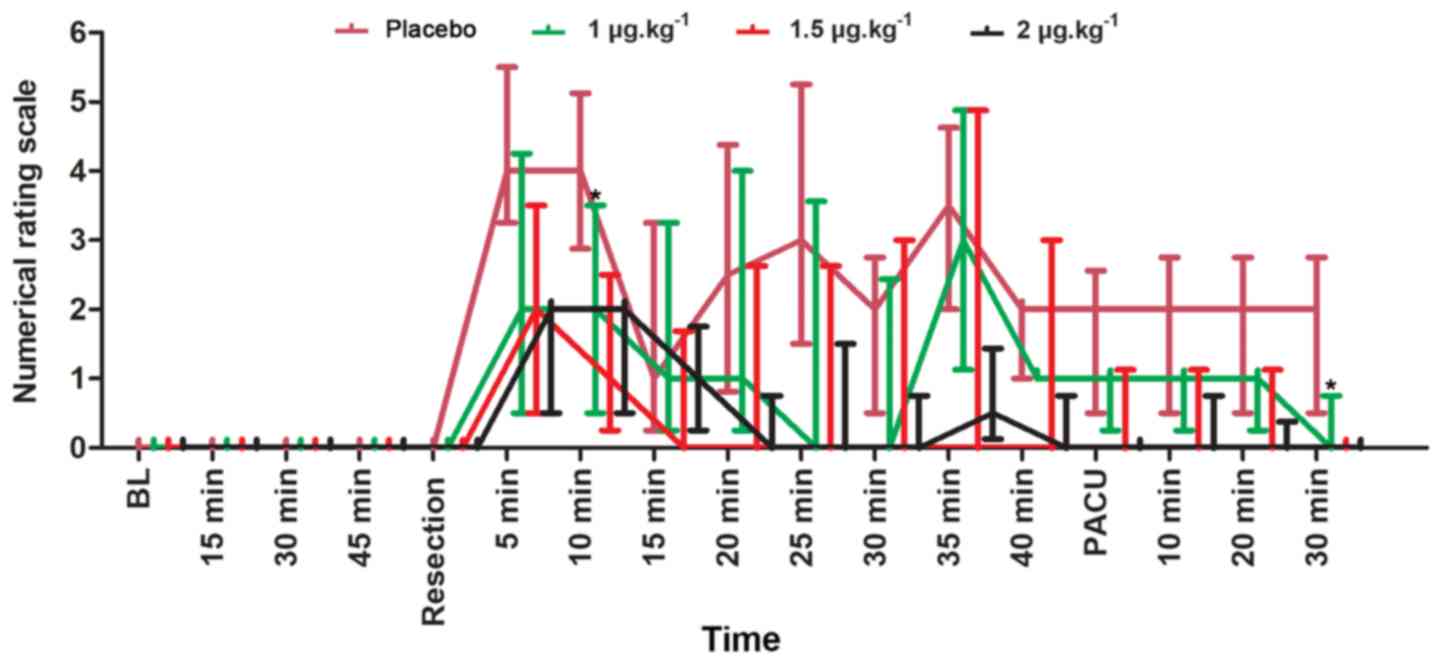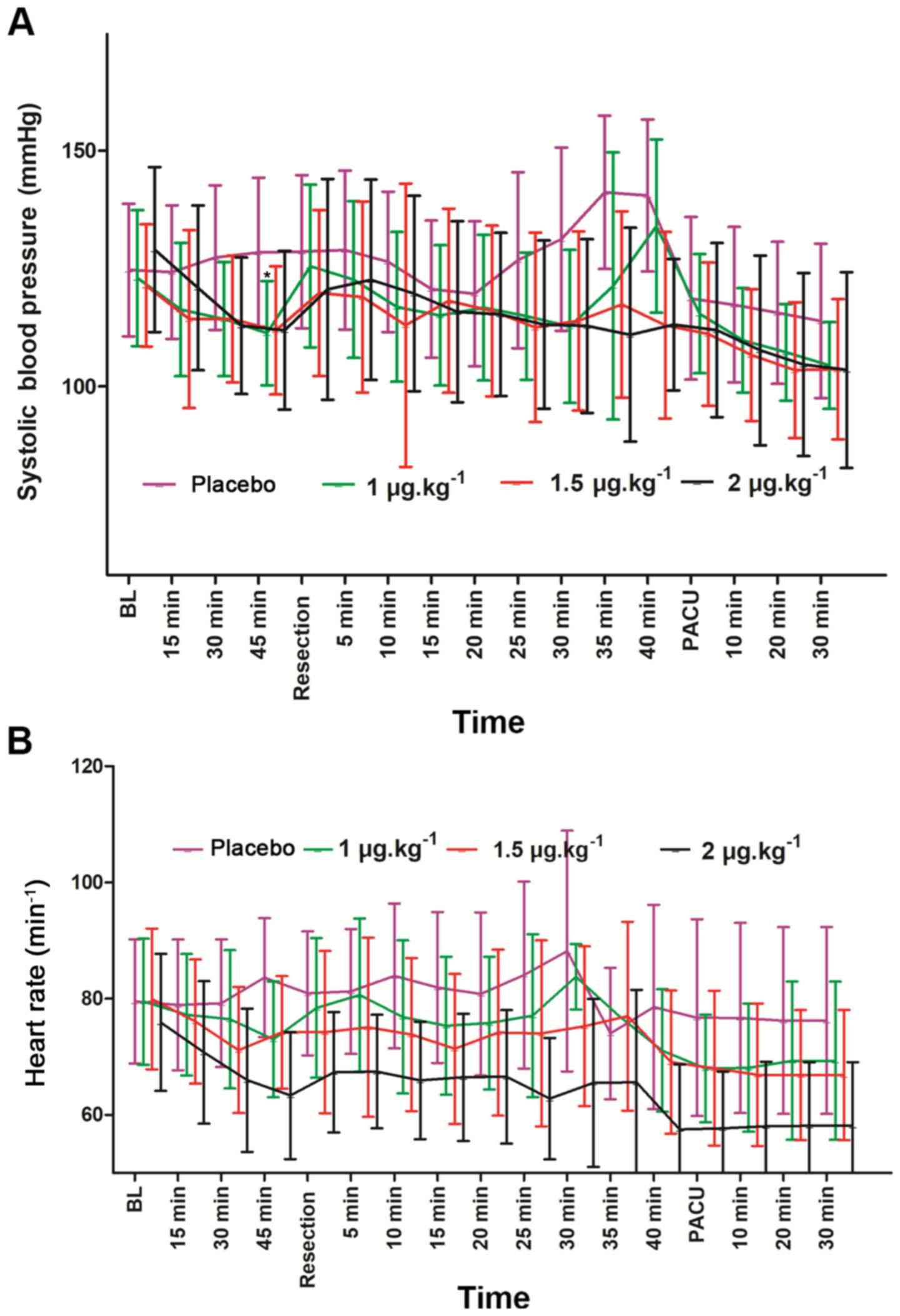|
1
|
Hong W and Dong E: The past, present and
future of breast cancer research in China. Cancer Lett. 35:1–5.
2014. View Article : Google Scholar
|
|
2
|
Li H, Zheng RS, Zhang SW, Zeng HM, Sun KX,
Xia CF, Yang ZX, Chen WQ and He J: Incidence and mortality of
female breast cancer in China, 2014. Zhonghua Zhong Liu Za Zhi.
40:166–171. 2018.(In Chinese). PubMed/NCBI
|
|
3
|
Tevis SE, Neuman HB, Mittendorf EA, Kuerer
HM, Bedrosian I, DeSnyder SM, Thompson AM, Black DM, Scoggins ME,
Sahin AA, et al: Multidisciplinary intraoperative assessment of
breast specimens reduces number of positive margins. Ann Surg
Oncol. 25:2932–2938. 2018. View Article : Google Scholar : PubMed/NCBI
|
|
4
|
Sessler DI, Pei L, Huang Y, Fleischmann E,
Marhofer P, Kurz A, Mayers DB, Meyer-Treschan TA, Grady M, Tan EY,
et al: Recurrence of breast cancer after regional or general
anaesthesia: A randomised controlled trial. Lancet. 394:1807–1815.
2019. View Article : Google Scholar : PubMed/NCBI
|
|
5
|
Pusch F, Freitag H, Weinstabl C, Obwegeser
R, Huber E and Wildling E: Single-injection paravertebral block
compared to general anaesthesia in breast surgery. Acta
Anaesthesiol Scand. 43:770–774. 1999. View Article : Google Scholar : PubMed/NCBI
|
|
6
|
Manfè AZ, Marchesini M, Bortolato A,
Feltracco P and Lumachi F: Ropivacaine versus levobupivacaine for
minor breast surgery in outpatients: Inversion of postoperative
pain relief efficacy. In Vivo. 26:1075–1077. 2012.PubMed/NCBI
|
|
7
|
Calì Cassi L, Biffoli F, Francesconi D,
Petrella G and Buonomo O: Anesthesia and analgesia in breast
surgery: The benefits of peripheral nerve block. Eur Rev Med
Pharmacol Sci. 21:1341–1345. 2017.PubMed/NCBI
|
|
8
|
FitzGerald S, Odor PM, Barron A and Pawa
A: Breast surgery and regional anaesthesia. Best Pract Res Clin
Anaesthesiol. 33:95–110. 2019. View Article : Google Scholar : PubMed/NCBI
|
|
9
|
Burgess C, Cornelius V, Love S, Graham J,
Richards M and Ramirez A: Depression and anxiety in women with
early breast cancer: Five year observational cohort study. BMJ.
330:7022005. View Article : Google Scholar : PubMed/NCBI
|
|
10
|
Sezen G, Demiraran Y, Seker IS, Karagoz I,
Iskender A, Ankarali H, Ersoy O and Ozlu O: Does premedication with
dexmedetomidine provide perioperative hemodynamic stability in
hypertensive patients? BMC Anesthesiol. 14:1132014. View Article : Google Scholar : PubMed/NCBI
|
|
11
|
Tang C, Hu Y, Zhang Z, Wei Z, Wang H, Geng
Q, Shi S, Wang S, Wang J and Chai X: Dexmedetomidine with
sufentanil in intravenous patient-controlled analgesia for relief
from postoperative pain, inflammation, and delirium after
esophageal cancer surgery. Biosci Rep. 40:BSR201934102020.
View Article : Google Scholar : PubMed/NCBI
|
|
12
|
Kang MH, Lee HJ, Lim YJ, Jeon YT, Hwang JW
and Park HP: Preoperative dexmedetomidine attenuates hemodynamic
responses to hydrodissection in patients undergoing robotic
thyroidectomy. J Anesth. 29:191–197. 2015. View Article : Google Scholar : PubMed/NCBI
|
|
13
|
Kang R, Jeong JS, Ko JS, Lee SY, Lee JH,
Choi SJ, Cha S and Lee JJ: Intraoperative dexmedetomidine
attenuates norepinephrine levels in patients undergoing
transsphenoidal surgery: A randomized, placebo-controlled trial.
BMC Anesthesiol. 20:1002020. View Article : Google Scholar : PubMed/NCBI
|
|
14
|
Poonai N, Spohn J, Vandermeer B, Ali S,
Bhatt M, Hendrikx S, Trottier ED, Sabhaney V, Shah A, Joubert G and
Hartling L: Intranasal dexmedetomidine for procedural distress in
children: A systematic review. Pediatrics. 145:e201916232020.
View Article : Google Scholar : PubMed/NCBI
|
|
15
|
Yang F, Liu Y, Yu Q, Li S, Zhang J, Sun M,
Liu L, Lei Y, Tian Q, Liu H and Tu S: The role of parents in
reporting sedation outcomes in our analysis of 17 948 pediatric
patients undergoing procedural sedation with a combination of
intranasal dexmedetomidine and ketamine. Paediatr Anaesth.
29:12082019. View Article : Google Scholar : PubMed/NCBI
|
|
16
|
Cheung CW, Ng KF, Liu J, Yuen MY, Ho MH
and Irwin MG: Analgesic and sedative effects of intranasal
dexmedetomidine in third molar surgery under local anaesthesia. Br
J Anaesth. 107:430–437. 2011. View Article : Google Scholar : PubMed/NCBI
|
|
17
|
Nooh N, Sheta SA, Abdullah WA and
Abdelhalim AA: Intranasal atomized dexmedetomidine for sedation
during third molar extraction. Int J Oral Maxillofac Surg.
42:857–862. 2013. View Article : Google Scholar : PubMed/NCBI
|
|
18
|
Svrakic M, Pollack A, Huncke TK and Roland
JT Jr: Conscious sedation and local anesthesia for patients
undergoing neurotologic and complex otologic procedures. Otol
Neurotol. 35:e277–e285. 2014. View Article : Google Scholar : PubMed/NCBI
|
|
19
|
Liu S, Wang Y, Zhu Y, Yu T and Zhao H:
Safety and sedative effect of intranasal dexmedetomidine in
mandibular third molar surgery: A systematic review and
meta-analysis. Drug Des Devel Ther. 13:1301–1310. 2019. View Article : Google Scholar : PubMed/NCBI
|
|
20
|
Mondardini MC, Amigoni A, Cortellazzi P,
Di Palma A, Navarra C, Picardo SG, Puzzutiello R, Rinaldi L, Vitale
F, Marinosci GZ and Conti G: Intranasal dexmedetomidine in
pediatrics: Update of current knowledge. Minerva Anestesiol.
85:1334–1345. 2019. View Article : Google Scholar : PubMed/NCBI
|
|
21
|
Messeha MM and El-Morsy GZ: Comparison of
intranasal dexmedetomidine compared to midazolam as a premedication
in pediatrics with congenital heart disease undergoing cardiac
catheterization. Anesth Essays Res. 12:170–175. 2018. View Article : Google Scholar : PubMed/NCBI
|
|
22
|
Gupta A, Dalvi NP and Tendolkar BA:
Comparison between intranasal dexmedetomidine and intranasal
midazolam as premedication for brain magnetic resonance imaging in
pediatric patients: A prospective randomized double blind trial. J
Anaesthesiol Clin Pharmacol. 33:236–340. 2017.PubMed/NCBI
|
|
23
|
Goyal S, Gupta KK and Mahajan V: A
comparative evaluation of intravenous dexmedetomidine and fentanyl
in breast cancer surgery: A prospective, randomized, and controlled
trial. Anesth Essays Res. 11:611–616. 2017. View Article : Google Scholar : PubMed/NCBI
|
|
24
|
Nakanishi T, Yoshimura M and Toriumi T:
Pectoral nerve II block, transversus thoracic muscle plane block,
and dexmedetomidine for breast surgery in a patient with
achondroplasia: A case report. JA Clin Rep. 5:472019. View Article : Google Scholar : PubMed/NCBI
|
|
25
|
Mohamed SA, Fares KM, Mohamed AA and
Alieldin NH: Dexmedetomidine as an adjunctive analgesic with
bupivacaine in paravertebral analgesia for breast cancer surgery.
Pain Physician. 17:E589–E598. 2014.PubMed/NCBI
|
|
26
|
Mak PH, Campbell RC and Irwin MG; American
Society of Anesthesiologists, : The ASA physical status
classification: Inter-observer consistency. American society of
anesthesiologists. Anaesth Intensive Care. 30:633–640. 2002.
View Article : Google Scholar : PubMed/NCBI
|
|
27
|
Wikström L, Nilsson M, Broström A and
Eriksson K: Patients' self-reported nausea: Validation of the
numerical rating scale and of a daily summary of repeated numerical
rating scale scores. J Clin Nurs. 28:959–968. 2019. View Article : Google Scholar : PubMed/NCBI
|
|
28
|
Iirola T, Vilo S, Manner T, Aantaa R,
Lahtinen M, Scheinin M and Olkkola KT: Bioavailability of
dexmedetomidine after intranasal administration. Eur J Clin
Pharmacol. 67:825–831. 2011. View Article : Google Scholar : PubMed/NCBI
|
|
29
|
Yuen VM, Irwin MG, Hui TW, Yuen MK and Lee
LH: A double-blind, crossover assessment of the sedative and
analgesic effects of intranasal dexmedetomidine. Anesth Analg.
105:374–380. 2007. View Article : Google Scholar : PubMed/NCBI
|
|
30
|
Wang HM, Shi XY, Zhou JL and Xia YF:
Comparison of dexmedetomidine and propofol for conscious sedation
in inguinal hernia repair: A prospective, randomized, controlled
trial. J Int Med Res. 45:533–539. 2017. View Article : Google Scholar : PubMed/NCBI
|
|
31
|
Miller JW, Divanovic AA, Hossain MM,
Mahmoud MA and Loepke AW: Dosing and efficacy of intranasal
dexmedetomidine sedation for pediatric transthoracic
echocardiography: A retrospective study. Can J Anaesth. 63:834–841.
2016. View Article : Google Scholar : PubMed/NCBI
|
|
32
|
Sheta SA, Al-Sarheed MA and Abdelhalim AA:
Intranasal dexmedetomidine vs. midazolam for premedication in
children undergoing complete dental rehabilitation: A
double-blinded randomized controlled trial. Paediatr Anaesth.
24:181–189. 2014. View Article : Google Scholar : PubMed/NCBI
|
|
33
|
Plambech MZ and Afshari A: Dexmedetomidine
in the pediatric population: A review. Minerva Anestesiol.
81:320–332. 2015.PubMed/NCBI
|
|
34
|
Jia JE, Chen JY, Hu X and Li WX: A
randomised study of intranasal dexmedetomidine and oral ketamine
for premedication in children. Anaesthesia. 68:944–949. 2013.
View Article : Google Scholar : PubMed/NCBI
|
|
35
|
Ryu DS, Lee DW, Choi SC and Oh IH:
Sedation protocol using dexmedetomidine for third molar extraction.
J Oral Maxillofac Surg. 74:926.e1–7. 2016. View Article : Google Scholar
|
|
36
|
Ebert TJ, Hall JE, Barney JA, Uhrich TD
and Colinco MD: The effects of increasing plasma concentrations of
dexmedetomidine in humans. Anesthesiology. 93:382–394. 2000.
View Article : Google Scholar : PubMed/NCBI
|
|
37
|
Zhang X, Bai X, Zhang Q, Wang X and Lu L:
The safety and efficacy of intranasal dexmedetomidine during
electrochemotherapy for facial vascular malformation: A
double-blind, randomized clinical trial. J Oral Maxillofac Surg.
71:1835–1842. 2013. View Article : Google Scholar : PubMed/NCBI
|
|
38
|
Mohta M, Kalra B, Sethi AK and Kaur N:
Efficacy of dexmedetomidine as an adjuvant in paravertebral block
in breast cancer surgery. J Anesth. 30:252–260. 2016. View Article : Google Scholar : PubMed/NCBI
|
|
39
|
Su F and Hammer GB: Dexmedetomidine:
Pediatric pharmacology, clinical uses and safety. Expert Opin Drug
Saf. 10:55–66. 2011. View Article : Google Scholar : PubMed/NCBI
|
|
40
|
Scholz J and Tonner PH:
Alpha2-adrenoceptor agonists in anaesthesia: A new paradigm. Curr
Opin Anaesthesiol. 13:437–442. 2000. View Article : Google Scholar : PubMed/NCBI
|
|
41
|
Piao G and Wu J: Systematic assessment of
dexmedetomidine as an anesthetic agent: A meta-analysis of
randomized controlled trials. Arch Med Sci. 10:19–24. 2014.
View Article : Google Scholar : PubMed/NCBI
|
|
42
|
Das R, Das RK, Sahoo S and Nanda S: Role
of dexmedetomidine as an anaesthetic adjuvant in breast cancer
surgery as a day-care procedure: A randomised controlled study.
Indian J Anaesth. 62:182–187. 2018. View Article : Google Scholar : PubMed/NCBI
|















